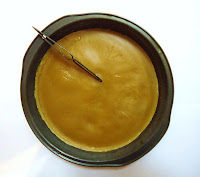First, I want to announce that the winner of the mini bottle of Fresh Life is SUN MI Please contact me at olympicorchids at gmail
dot com or leave a message on Facebook with your complete, correct name and shipping
address.
On the last Materials Wednesday when I posted on perfume carriers, there was talk about
solid perfumes, so it seems reasonable to cover that, too. Personally, I’m not
a fan of solid perfumes, but I know many people like them.
Basically, solid perfumes are fragrance in a carrier of wax
and oil in a ratio that makes the resulting mass solid but spreadable. The
fragrance can be anything from essential oils to ready-made synthetic fragrance
oils or concentrates. The solid wax is heated enough to melt it, and the carrier
oil and fragrance oil are added in whatever ratio gives the desired consistency
and scent. While liquid, the mixture is poured into a small tin or jar, where
it is allowed to solidify, and voila! You have solid perfume.
The high-end commercial “natural” and/or low-end DIY solid
perfume formulas typically use beeswax, candelilla wax, carnauba wax, shea
butter, cocoa butter, or mango butter along with various liquid oils like
almond, coconut, olive, sunflower, grape seed, or jojoba. Many of these ingredients
have scents of their own, so contribute subtly to the final fragrance, which is
one reason why solid perfumes often smell a little different from liquid ones.
There are not a lot of mass-market commercial solid perfumes,
and those that exist do not disclose all of their ingredients, but they probably
use soy wax, paraffin wax, deodorized castor oil, mineral oil, and small
amounts of other “natural”-sounding waxes and oils like the ones mentioned
above, along with synthetic/mixed-media fragrance concentrates.
Next week I’ll actually start on the perfume materials
themselves.
[Beeswax photos are from Wikimedia, solid perfume photos from retailers' websites, and Fresh Life bottle from Fragrantica]









Thank you for the details on solid perfumes! I am actually also not a fan of solid perfumes, because they maybe wear too close to the skin for me? Not sure if that is me imagining it, or a function of the aromachemicals interacting with the solid carrier. I do know people who strongely prefer solid perfumes because they find the smell of alcohol-based perfumes too alcohol-y...which I don't understand either :)
ReplyDeleteI think the perception of liquid perfumes as too "alcohol-y" is an illusion created by the idea that the perfume contains alcohol, and by the fleeting perception of alcohol for a few seconds when the perfume is first applied. There is no way that the alcohol smell could persist. On the other hand, the smell of carrier waxes and oils in solid perfumes does persist, muddying and muting the smell of the fragrance itself. Some people probably like that. I happen not to.
Delete